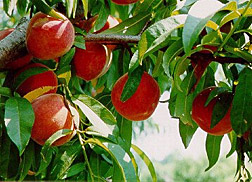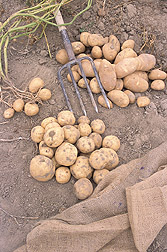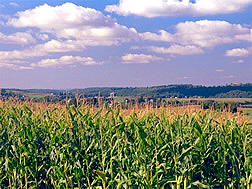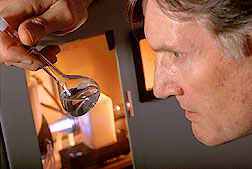| January 2004 |
Whey to Go! New Process Adds Protein to Snacks, Cereals
Corn puffs, cheese curls, crispy breakfast cereals and other crunchy "puffed" foods may soon offer up to seven times more protein. That's if they're made with protein-rich whey, left over after cheesemaking. ARS food technologists in Wyndmoor, Pa., developed and are seeking a patent for their novel technique for this use of whey protein. The new process uses a standard industrial food-processing device called a twin-screw extruder. The scientists developed moisture and temperature specifications for the processor so that adding whey won't interfere with the taste, color or crunchiness of food products. For more information, contact Charles I. Onwulata, (215) 233-6497; USDA-ARS Eastern Regional Research Center, Wyndmoor, PA. Study Examines Problematical LDL-Cholesterol Particles
Consuming high levels of hydrogenated fat--found in products like stick margarines--may contribute to higher levels of small, unhealthy particles of low-density lipoproteins, or LDL, in the blood. Hydrogenation converts liquid oils into solid fats. People with a higher proportion of these LDL particles in their blood, in relation to larger-sized particles, have a significantly increased risk of heart disease--even if their total LDL level is relatively normal. Scientists at the ARS Jean Mayer USDA Human Nutrition Research Center on Aging, Boston, Mass., and their co-investigators detected the association between hydrogenation and higher levels of the smaller-sized LDL particles. They determined that in a test with 18 men and 18 women, aged 52 to 73. The volunteers followed five, 35-day experimental regimens that included spreads with different degrees of hydrogenation--semiliquid margarine, soft margarine, shortening, stick margarine or butter. The findings appeared in the September 2003 American Journal of Clinical Nutrition (vol. 78, pp. 370-375). For further information, contact Alice H. Lichtenstein, (617) 556-3127; ARS Jean Mayer USDA Human Nutrition Research Center on Aging at Tufts University, Boston, MA. A Pinch of Cinnamon: Will It Help Type II Diabetics?A very small quantity of ground cinnamon--less than a half-teaspoon a day--helped volunteers with type II diabetes mellitus reduce their levels of blood sugar-–and reduce several cardiovascular disease risk factors, as well. That's according to a preliminary study of a small group of volunteers--60 men and women, all of whom had been diagnosed several years earlier with type II diabetes. ARS scientists at Beltsville, Md., and their university colleagues in Peshawar, Pakistan, conducted the 60-day study and reported their findings in the December 2003 issue of Diabetes Care (vol. 26, pp. 3215-3218). 
An estimated 17 million Americans have type II diabetes, in which insulin, the hormone that regulates their cells' use of sugar, is insufficient in quantity or incorrectly recognized by the body. The disorder causes unhealthy levels of sugar to build up in their blood. Volunteers, aged 40 to 65, ate one of three different quantities of cinnamon for 40 days of the study. Or they took cinnamon-free capsules that mimicked the size and number of the cinnamon capsules. Participants who received any of the three quantities of cinnamon lowered their blood sugar levels by 18 to 29 percent. They also lowered their levels of triglycerides (23 to 30 percent), total cholesterol (12 to 26 percent) and LDL cholesterol (7 to 27 percent). That's important, because high levels of those biochemicals are risk factors in heart disease. Individuals with type II diabetes are two to four times more likely to develop cardiovascular disease than people without diabetes. The researchers found no advantage in eating more than the smallest dose. They point out the study is preliminary and is based on findings from a relatively small group of volunteers. For more information, contact Richard A. Anderson, (301) 504-8091; USDA-ARS Beltsville Human Nutrition Research Center, Beltsville, MD. How Many Calories Do You Burn? Instruments Provide Faster Answers
Three new, high-tech devices should make it easier, faster and less expensive to determine how many calories your body burns. Scientists at the ARS Western Human Nutrition Research Center, Davis, Calif., are assessing the accuracy of the inexpensive, simple-to-use instruments. They're also determining the best combination of the devices for use in research and for physicians and other healthcare professions to use in helping patients maintain a healthy weight. Today, severe overweight, or obesity, is America's No. 1 nutrition problem. Two of the instruments are lightweight, pocket-size "activity monitors" for calculating the number of calories burned through physical activity. Worn attached to a belt or waistband, the monitors use motion-sensor technology to record the wearer's movements. The third instrument, a convenient, hand-held device, may replace today's bulky apparatus used to gauge "resting metabolic rate," or RMR--the number of calories an individual burns while sitting quietly. Resting metabolic rate and physical activity together account for about 90 percent of the calories that people burn everday. For further information, contact Mary J. Kretsch, (530) 752-4171; USDA-ARS Western Human Nutrition Research Center, Davis, CA. How "Failure to Thrive" Affects Young Brains
A nutrition problem called "failure to thrive" or "FTT," usually apparent in the first three years of life, can affect brainpower of pre-teens and teens. An ARS-funded study at the Arkansas Children's Nutrition Center, Little Rock, provides new details about the difference in brain function between 27 youngsters aged eight to 15 who had been diagnosed with FTT early in life, and 17 peers who had not. FTT volunteers had significantly lower scores in standard reading, spelling and math tests than youngsters whose childhood development was normal. In another standard test that requires repeated, careful decision-making, the FTT kids' brain waves were different from those of young people with normal development. The study is part of research to delineate the relation between nutrition and brain function and, ultimately, to alleviate FTT and its consequences. More than 200,000 infants born each year in the United States have FTT, meaning that they have an abnormally low weight for their age or have an abnormally low weight gain over time. Previous research by the Arkansas scientists has shown that FTT kids who eat as much, or more than, their counterparts can't make full use of those foods to grow as expected. For more information, contact Terry Pivik, (501) 364-3342; USDA-ARS Arkansas Children's Nutrition Center, Little Rock, AR. Discovering More About Kids and Exercise
Kids' attitudes about their athletic abilities may influence whether they regularly exercise later in life--and may also influence their future risk of developing cardiovascular disease. A study of 900 middle-school children and their changing attitudes about their own athletic abilities may reveal more. Youngsters of that age group were singled out for the study because the biggest drop in children's physical activities tends to occur as they move from middle school to high school. The investigators are tracking seventh graders into eighth and ninth grades, and eighth graders into ninth and tenth grades, to learn about their physical activity schedules and their attitudes towards themselves as individuals who are athletic or who exercise to keep fit. ARS-funded scientists at the Children's Nutrition Research Center in Houston, Texas, are leading the four-year investigation, sponsored by the National Institutes of Health. For further information, contact Cheryl B. Anderson, (713) 798-0773; USDA-ARS Children's Nutrition Research Center at Baylor College of Medicine, Houston, TX. Soy-Based Breads Have a Great New Taste!
Soy flour-based breads that taste as good as today's familiar wheat-flour breads have been developed by an ARS "chemist-turned-baker." Taste testers evaluated the unique, high-protein breads made with ARS' new dough formulations. The novel breads are high in fiber and other healthful compounds such as isoflavones. In particular, loaves containing 30 to 40 percent soy flour provide 112 to 127 grams of protein, compared to 65 grams of protein found in typical wheat-flour breads. The pleasing, slightly dense texture of the soybreads is comparable to that of premium, multigrain breads and other specialty or artisan loaves. The scientists overcame soy's "beany" aftertaste--a problem with yesterday's soy-flour breads--by novel combinations of yeast, sugar and ascorbic acid. They described their research in the August 2003 Journal of Food Science (vol. 68, pp. 2141-2145). For more information, contact Randal L. Shogren, (309) 681-6354; USDA-ARS National Center for Agricultural Utilization Research, Peoria, IL. "Gulfprince"--Luscious New Southern Peach
A sweet, juicy new peach called "Gulfprince" may begin showing up in the produce section of some markets this coming summer. Developed by ARS scientists in Byron, Ga., and their university colleagues, this peach can tree-ripen for three to four days longer than most other kinds of peaches, giving it more time to become sweeter, juicier and more aromatic. Gulfprince, best suited for growing in the Atlantic and Gulf states of Georgia, Florida, Alabama, Mississippi, Louisiana and Texas, was planted in commercial orchards beginning in 2001. In Georgia, Gulfprince typically ripens in early June. The trees bear plump, yellow-fleshed fruits that are about two-and-one-half inches in diameter. These peaches are slow to soften and don't bruise easily, so they hold up well on the trip from growers' orchards to your home. For further information, contact Thomas Beckman, (478) 956-6436; USDA-ARS Fruit and Tree Nut Research Laboratory, Byron, GA. "Ivory Crisp" Potato: Perfect for Chips
Thinly sliced Ivory Crisp potatoes make delicious, golden-brown potato chips. Developed by university and ARS scientists in the Northwest Potato Variety Development Program, this potato's favorable ratio of starch to sugar prevents the unattractive dark spots and burnt flavor that can occur when frying potatoes that have a higher amount of sugar. Ivory Crisp keeps that ratio, even in the prolonged cold storage that many "chipping" potatoes undergo. After tests in Idaho, Oregon and Washington, scientists determined that Ivory Crisp was ready to offer to growers (May-June 2003 American Journal of Potato Research, vol. 80, pp. 207-213). For more information, contact Richard G. Novy, (208) 397-4181, ext. 111; USDA-ARS Small Grains and Potato Research Unit, Aberdeen, ID. Vitamin E-Rich Sweet Corn Ahead
Tomorrow's sweet corn could offer more vitamin E than before, as a result of research by ARS scientists and their collaborators. That's good news for people who like fresh or frozen corn-on-the-cob, canned creamed corn or other sweet corn products. Right now, 25 percent of Americans don't get enough vitamin E. Research has shown that this essential nutrient, found in green vegetables, nuts and vegetable oil, is especially important for a healthy pregnancy. And, it can decrease the risk of heart disease. ARS scientists in St. Louis, Mo., and their colleagues borrowed genes from rice, barley and wheat--which contain higher levels of vitamin E than corn--to develop the new corn (September 2003, Nature Biotechnology, vol. 21, pp. 1082-1087). The scientists investigated a little-studied pathway that plants use to make a form of vitamin E known as a tocotrienol. They isolated a gene that is critical in this biochemical pathway, then moved that gene into experimental corn plants. The result? A sixfold increase in kernels' vitamin E content. Similar studies with soybeans are under way. For further information, contact Edgar B. Cahoon, (314) 587-1291; USDA-ARS Plant Genetics Research Unit, St. Louis, MO. Micronutrients Targeted in Food Enrichment Strategies
HarvestPlus--a new program designed to overcome micronutrient malnutrition in developing nations--will employ discoveries from ARS research to boost the nutritional value of such crops as rice, corn, wheat, beans, sweet potato and cassava. ARS studies of the genes that control plants' levels of micronutrients such as iron, zinc and beta-carotene will have a key role in HarvestPlus. Scientists at the ARS Children's Human Nutrition Research Center, Houston, Texas, and at the ARS U.S. Plant, Soil and Nutrition Laboratory, Ithaca, N.Y., are leading this work. The micronutrients in these new, naturally enhanced plants need to be readily available for the body to digest and absorb. ARS experts at Ithaca will scrutinize bioavailability, using laboratory-cultured human intestinal cells to simulate the way we digest and absorb nutrients. Colleagues at Cornell University will further investigate the enriched plants in tests with pigs. Scientists at the ARS Grand Forks (N.D.) Human Nutrition Research Center will confirm these laboratory findings, in follow-up studies with volunteers. Enriching plant-derived foods by improving the nutrient composition of the plant itself is known as biofortification. That's in contrast to fortifying foods--after harvest--at the processing plant. For more information, contact Ross M. Welch, (607) 255-5434; USDA-ARS U.S. Plant, Soil and Nutrition Laboratory, Ithaca, NY. |
|
The United States Department of Agriculture (USDA) prohibits discrimination in all its programs and activities on the basis of race, color, national origin, gender, religion, age, disability, political beliefs, sexual orientation, and marital or family status. (Not all prohibited bases apply to all programs.) Persons with disabilities who require alternative means for communication of program information (Braille, large print, audiotape, etc.) should contact USDA's TARGET Center at 202-720-2600 (voice and TDD). To file a complaint of discrimination, write USDA, Director, Office of Civil Rights, Room 326-W, Whitten Building, 14th and Independence Ave., SW, Washington, DC 20250-9410 or call 202-720-5964 (voice or TDD). USDA is an equal opportunity provider and employer. |

